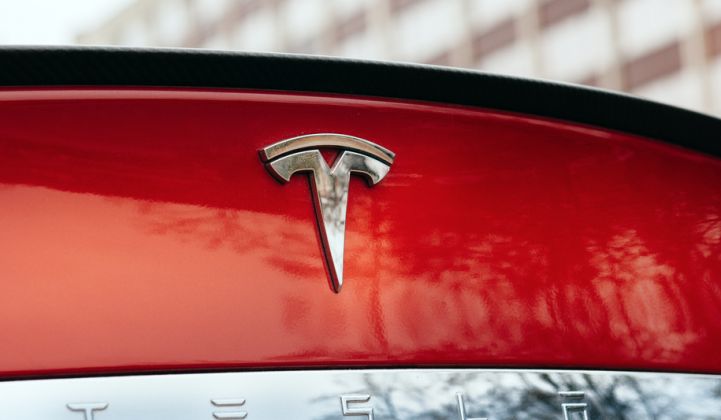If investors and analysts expected to get much new information on Tesla's bid to buy SolarCity today, they were mistaken.
In order to shore up support for the acquisition, Tesla released a modified version of a pitch to investors -- a nine-page document that outlines the two business models of Tesla and SolarCity, and how they might work better under one company. Elon Musk and his two cousins, Lyndon and Peter Rive, also held an analyst call.
This was an attempt to offer additional details on the partnership. The Tesla-SolarCity "strategic rationale" document does indeed offer some hints about SolarCity's financial performance.
For example, roughly one-third of SolarCity's new solar customers are now opting for loans or cash purchases. "As a combined company, we expect this percentage to continue to increase in 2017," argues Tesla.
SolarCity is also improving its cash position. "SolarCity increased its cash balance from Q2 to Q3 2016. And as SolarCity further shifts its product mix to cash sales and loans, it will further increase the upfront cash generation of new installations and expects to increase its cash balance even more in Q4 2016."
Tesla also expects SolarCity to boost its own cash position. "We also expect SolarCity to immediately account for 40% of the assets of the combined company on a historical cost basis, to contribute $1+ billion in revenue in 2017, and to add more than half a billion dollars in cash to Tesla’s balance sheet over the next 3 years."
However, the investor call with Musk and the brothers Rive revealed very little additional insight.
Here's what they did manage to reveal -- or not reveal -- about the combined companies.
SolarCity isn't totally abandoning Silevo
SolarCity bought the high-efficiency solar startup Silevo for $177 million in cash and stock. But when Tesla brought in Panasonic as a partner in SolarCity's manufacturing plant last month, many wondered if the companies were abandoning Silevo's technology altogether.
But that's not the case. "It's going to be a partnership deal," said SolarCity CTO Peter Rive.
He explained that the two companies would combine technologies: "I don't think there's any material changes. The approach is that both Silevo and Panasonic have two cells that are actually the same kind of base design. Then there's components of each technology that we're gonna take and create a hybrid version of each of them. So we expect all the equipment to be perfectly applicable to the new cell process."
So far, 15 percent to 20 percent of the equipment has been delivered to the plant in Buffalo, New York.
Later in the call, Rive offered more clues about the partnership: "We are basically going to bring the best learnings from both of the teams. Silevo has perfected a heterojunction cell using a 6-inch wafer. And Panasonic has yet to transition to a 6-inch wafer. So we'll kind of take Silevo's learnings on 6-inch [wafer] and apply that to the learnings that Panasonic has achieved over the years scaling heterojunction cells to gigawatts and beyond."
Rive also said he thinks that Silevo-Panasonic can get to 40 cents a watt "over time and with scale."
No one was sure how to explain that $150 million in 'synergies'
From the beginning, Tesla has been touting the cost savings that could be realized by acquiring SolarCity.
"We’ve already stated that we believe we can realize more than $150 million of direct cost synergies within the first full year after closing. These savings are from sales and marketing efficiencies through cross-selling, the elimination of overlapping R&D and product development efforts, and reduced overhead costs," argues Tesla in its new strategic document.
But when asked about whether they had any data to back those synergy claims up, no one had a good answer.
Musk: "We've not surveyed our customers on this. So it would be somewhat speculative. But I don't know, Lyndon, if you have any."
Rive's only response: "I think the overlap on the Model 3 will be quite dramatic."
These supposed "synergies" are the strategic pillar of the acquisition. And neither Rive nor Musk could give an example of how the companies might work better together.
So what if the companies don't merge? If investors vote down Tesla's plan, the company would be forced to keep SolarCity at "an arm's length," said Musk.
"We'd just have a more clunky product offering where we'd just be selling batteries, SolarCity would be selling solar systems. They wouldn't be well-integrated as a package. We wouldn't have a good basis for favoring SolarCity, because they'd be a separate company," he said.
SolarCity may have hinted at becoming a roofing company
Musk didn't provide any information on cost or performance during the unveiling of Tesla's solar roof last week. And he failed to do so on today's call.
But he and Lyndon Rive did drop a couple hints on how the business model might work. They suggested that the combined companies would want to circumvent the distribution chain -- perhaps an opportunity to get into roofing themselves?
"The distribution process is another reason why a [solar roof] hasn't succeeded," said Rive. "You have multiple people in the value chain who each add a compounding margin -- and then the end product was just too expensive."
Musk responded: "Yeah, exactly, it's overhead and profit to the fifth power with a lot of inefficiency in the distribution chain."
This is how Musk operates. If he sees an inefficiency, he brings that part of the business in-house. It's to early to know -- "It’s going to take a long time to make the solar roof to scale," admitted Musk -- but it's possible that the solar roof pushes Tesla-SolarCity further into vertical integration.
Take a listen to our conversation about the pros and cons of Tesla's solar roof.



